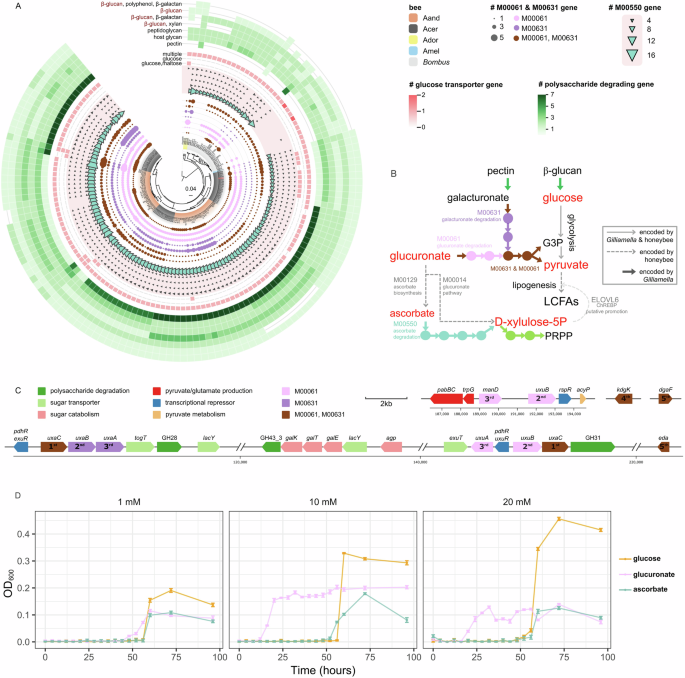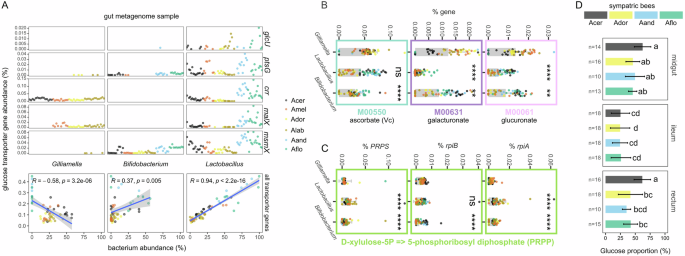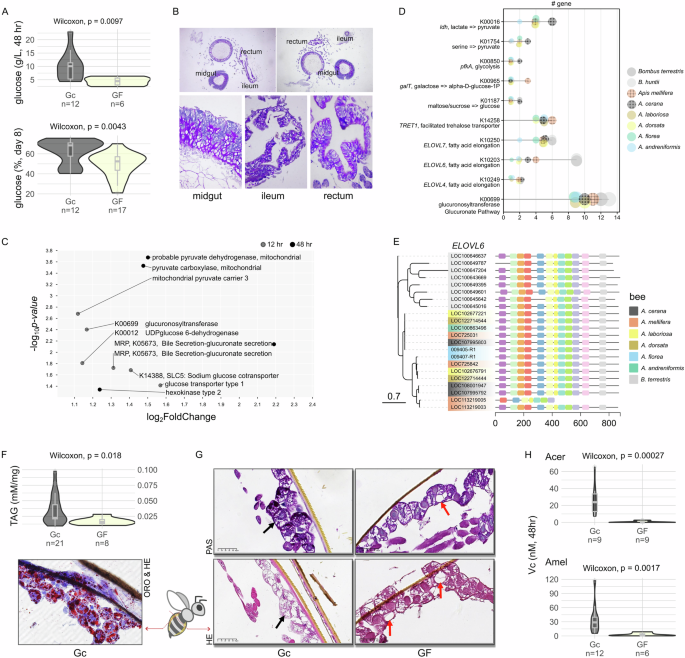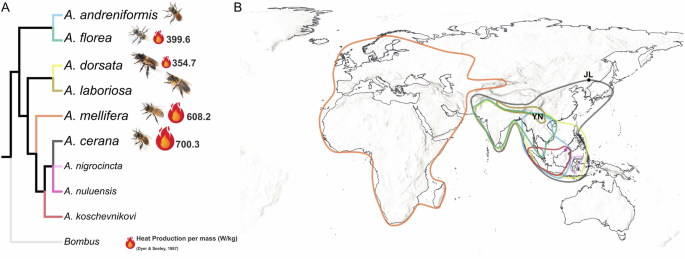Gilliamella is most significantly enriched in cold-adapted honeybee guts
We performed metagenome shotgun sequencing on the two cold-resistant honeybees (A. mellifera & A. cerana) and four tropical honeybees (dwarf honeybees A. andreniformis, A. florea, and giant honeybees A. dorsata, A. laboriosa). A total of 70 samples from 168 bee hindguts were obtained from Jilin and Yunnan Provinces, China (Fig. 1B, Fig. 2A, Fig. S1a, Supplementary Data 1) and used to investigate the characteristic gut microbiota of cold-adapted honeybees. The gut microbiota composition confidently divided the six honeybee species into three distinct groups (partial least squares test: Q2Y = 0.783), in line with their phylogenetic relationships (Fig. 2A, Fig. S1b, c). To test whether the gut microbiota composition is influenced by cold climate, independent of host phylogeny, we need to identify which bacterial members are associated with cold tolerance. Core bacteria, Gilliamella, Apibacter, Frischella, Bartonella, and Snodgrassella have contributed mainly to the partition and clustering of the cold-adapted bee group (Fig. 2A). Among these, Gilliamella was barely detected in dwarf bees (Fig. S1b), whereas it was most significantly enriched (Fig. 2B) in the cold-resistant bees, despite typically occurring in the giant honeybees. In contrast, the gram-positive bacteria Lactobacillus and Bifidobacterium predominated in the gut of dwarf honeybees, while Gammaproteobacteria and Bacteroidota, such as Dysgonomonas and Apibacter, outcompeted others in giant honeybees.
A Principal component analysis of gut bacteriome showing bacteria most strongly separating different bees. B Significantly enriched gut bacteria identified in the three honeybee subgenera. LDA: linear discriminant analysis. C Apis cerana workers with (Gc) or without (GF) Gilliamella colonization were subject to thermo imaging after cold exposure (10 °C) for 30 min. AV, average temperature for the framed area; HS and CS denote the highest and lowest temperatures for the entire area, respectively. D The same sets of bees were measured for abdominal temperature after 4 h cold exposure, using a thermocouple (the needle-like instrument touching the bee’s abdomen, as shown in the right photograph of the middle insert). Acer, A. cerana; Amel, A. mellifera; Ador, A. dorsata; Alab, A. laboriosa; Aand, A. andreniformis; Aflo, A. florea.
Gilliamella colonization improves host heat production and cold tolerance
To determine the potential impact of Gilliamella on honeybees’ cold resistance, we compared A. cerana workers monocolonized by Gilliamella to germ-free controls, measuring their cold tolerance at 10 °C. On day 8 post-inoculation, as detected by colony-forming unit (CFU) count, the Gilliamella strain B3835 stably colonized the bee hindguts at densities of 107–108 cells per gut (Fig. S1d). When exposed to the cold condition for 30 min, Gilliamella-colonized groups remained active, while the germ-free groups became immobilized (Supplementary Movie 1). The bees sustained a higher body temperature when colonized with Gilliamella (as measured by thermal imaging, Fig. 2C). This difference remained significant after four hours of cold exposure as examined by the abdominal temperatures using a thermocouple (Fig. 2D). In contrast, the colonization of a Lactobacillus strain isolated from A. andreniformis did not improve A. mellifera thermogenesis (Fig. S1e), indicating that not all honeybee gut bacteria can enhance host cold-tolerance. These results indicate that Gilliamella increased heat production in the host, thereby enhancing cold tolerance.
Gilliamella excels in producing key energy substrates: pyruvate and glucose
To evaluate the capacity of Gilliamella in its potential contribution to host thermogenesis, we inspected 149 Gilliamella genomes, as well as 17 Lactobacillus and 28 Bifidobacterium genomes (Fig. 3A, Fig. S2, 3, Supplementary Data 1). Among all core gut bacteria derived from western honeybees, Gilliamella was experimentally shown to be superior in producing pyruvate and cross-feed Snodgrassella24. Hence, we explored the underlying metabolic pathways producing energy substrates required by thermogenesis, such as pyruvate25. Our results showed that besides glycolysis, all Gilliamella strains derived from cold-adapted honeybees can produce pyruvate via two dedicated metabolic modules that degrade glucuronate or galacturonate (Fig. 3A, B). No Lactobacillus or Bifidobacterium strain encodes the full glucuronate degradation module, and only a few Bifidobacterium strains possess the galacturonate degradation module (Fig. S3), highlighting Gilliamella’s metabolic features in pyruvate production.

A Maximum-likelihood phylogeny of Gilliamella strains, annotated with the number of genes involved in carbohydrate metabolism: enzymes involved in degradation modules of glucuronate (M00061), galacturonate (M00631), and ascorbate (M00550); proteins transporting only glucose, glucose and maltose, or multiple sugars including glucose; primary hydrolases targeting polysaccharides. Circle and triangle sizes indicate gene copy number. B Schematic metabolic pathways inferred from Gilliamella and honeybee genomes. The Gilliamella-generated substrates can be potentially utilized by the host in lipogenesis. G3P glyceraldehyde 3-phosphate, LCFAs long-chain fatty acids, ELOVL6 elongation of very long chain fatty acids protein 6, ChREBP carbohydrate-responsive element binding protein, PRPP 5-phosphoribosyl diphosphate. C Gene clusters involved in polysaccharide deconstruction and further utilization generating pyruvate in the strain Gilliamella B3835. D Differential growth of Gilliamella on varied carbon sources demonstrates its preference for glucuronate, resulting in lower cell density. The Gilliamella B3835 strain was cultured in Brain Heart Infusion (BHI) broth (minus glucose) supplemented with 1, 10 or 20 mM of glucose, glucuronate, or ascorbate, respectively. Data are presented as means ± SD.
Galacturonate is a backbone unit of pectin, where glucuronate is occasionally found as a side chain unit26,27. Gilliamella can hydrolyze refractory polysaccharides, especially pectin from pollen walls, releasing sugars as energy sources26,28. Our results unraveled prevalent gene clusters in the Gilliamella genome that contain modules responsible for polysaccharide degradation and subsequent monosaccharide transport and catabolism. For instance, in strain B3835 from A. cerana (Fig. 3C), genes for galacturonate and glucuronate degradation are located close to genes encoding pectin-degrading enzymes GH2829 and GH3130, while the transporters and catabolic enzymes for galactose are adjacent to β-D-galactofuranosidase GH43_3. Intriguingly, a pyruvate dehydrogenase complex repressor (pdhR) is encoded nearby, suggesting that downstream pyruvate catabolism can be suppressed. These enzymes are organized into carbohydrate-active enzyme gene clusters (CGCs)31, members of which are typically co-expressed32, enabling efficient stepwise conversion of polysaccharides into energy substrates.
In addition to pectin, we found that Gilliamella can also hydrolyze β-glucan, which is another abundant polysaccharide component of the pollen coat (Fig. 3A). The backbone of hemicellulose β-glucan is glucose27, which could serve as a direct energy resource for Gilliamella. However, to utilize glucose as a routine energy supply, Gilliamella would require glucose-specific transporters, which we found surprisingly missing in their genomes. Almost all Gilliamella strains possess only one gene copy (mostly gene crr) to transport multiple sugars, including glucose (Fig. 3A, Supplementary Data 1). Alternatively, because bacteria secrete hydrolases for saccharification, Gilliamella is expected to release a considerable amount of glucose into the hindgut, which could become accessible to the host for lipogenesis33,34 and thermogenesis34,35. Complementary to their limited glucose uptake, Gilliamella strains possess numerous genes for utilizing alternative saccharides, such as galactitol, fructose, mannose, and β-glucoside (Fig. S2). Particularly, most transporter genes target ascorbate. Gilliamella encodes an intact ascorbate degradation module generating D-xylulose-5P, which is lacking in most Lactobacillus strains and all Bifidobacterium strains (Fig. 3A, B, Fig. S3). D-xylulose-5P can be converted to energy and 5-phosphoribosyl diphosphate (PRPP), a key nucleotide precursor, via the pentose phosphate pathway. Therefore, Gilliamella is capable of utilizing a diverse range of alternative saccharide substrates in the gut.
To assess the growth performance of Gilliamella on different carbohydrate sources, we simultaneously cultured Gilliamella using a Brain Heart Infusion (BHI) broth without glucose, supplemented with glucuronate, ascorbate, or glucose (Fig. 3D). Compared to glucose and ascorbate, glucuronate-fed cultures evidently entered the log phase earlier, demonstrating a preference for glucuronate, thus validating our prediction based on genomics. Intriguingly, when supplied with equal molar amounts of carbon, glucuronate and ascorbate yielded cultures that plateaued at lower OD600 values than glucose, indicating a lower proliferation on these substrates. These decreased cell densities are expected to consume less carbon sources, potentially alleviating competition with both the host and other gut microbes. Additionally, 10 mM glucuronate or ascorbate at 10 mM supported higher growth than 20 mM, indicating that Gilliamella thrives at moderate substrate concentrations.
Microbiome analysis corroborates Gilliamella’s strength in energy generation
To investigate the impact of Gilliamella enrichment on gut microbiome function, we quantified the relative abundance of carbohydrate metabolic pathways and their bacterial contribution in the gut metagenomes of six Apis honeybees. Our results showed that the abundance of genes encoding transporters capable of glucose uptake was negatively correlated with Gilliamella’s abundance, but positively correlated with that of Lactobacillus and Bifidobacterium (Fig. 4A). Our genome analyses (Fig. 3A, Supplementary Data 1) showed that most Gilliamella strains lack dedicated glucose transporters (e.g., glcU, ptsG) and instead carry only crr, which transports a broad range of sugars. Consistently, our metagenomic data reveal that glcU, ptsG, and the multiple sugar transporter msmX are rarely encoded by Gilliamella (Fig. 4A), with the maltose/glucose transporter malX found in strains derived from giant honeybees and a few western honeybees. In contrast, ptsG and msmX are common in Bifidobacterium, and especially abundant in Lactobacillus from dwarf honeybees, reflecting their robust glucose-uptake capacity. Hence, our findings from bacterial strain genomes and gut metagenomics both suggest that the enrichment of Gilliamella corresponds to a reduced overall capacity for glucose uptake within the gut microbiota of cold-adapted honeybees.

A The gene abundance of glucose transporters in gut metagenomes contributed by varied bacteria. The y-axis is the gene abundance of transporters capable of glucose uptake. Pearson correlation coefficient (R) and P value (p) are annotated. Gilliamella rarely encodes glucose transporters, especially glucose-specific transporters (glucU and ptsG), across all metagenome samples (upper panel). And its abundance is negatively associated with the abundance of all glucose transporters in metagenomes (lower panel). The abundance comparison of genes encoded by three gut bacteria in the (B) degradation module of glucuronate, galacturonate and ascorbate, and (C) PRPP production from D-xylulose-5P shows Gilliamella’s superior degradation capacity in alternative carbon sources whereas lower consumption of D-xylulose-5P. ns: no significant difference, **P value < 0.01, ****P value < 0.0001 by Mann–Whitney U test (B–D). Each dot denotes one gut metagenome sample. D Glucose proportions across gut tissues in four sympatric honeybees, A. cerana (Acer), A. dorsata (Ador), A. andreniformis (Aand) and A. florea (Aflo), examined by saccharide metabolomics show significantly more glucose in Acer rectums. Two-way ANOVA and Tukey test were used for the comparison. Data are presented as means ± SD.
With regards to carbohydrate metabolism, Gilliamella allocates more genes for pentose and glucuronate interconversions than Lactobacillus and Bifidobacterium (Fig. S4a), specifically for the degradation modules of glucuronate, galacturonate, ascorbate and pectin (Fig. 4B, Fig. S4b). This leads to enhanced production of pyruvate and D-xylulose-5P. Meanwhile, Gilliamella encodes fewer genes that convert D-xylulose-5P to D-ribose-5P and the downstream PRPP (Fig. 4C, Fig. S4c).
To test whether enriched Gilliamella in gut microbiome affects the availability of hindgut glucose for honeybee hosts, we applied saccharide metabolomics across the gastrointestinal tract of various honeybee species (Fig. 4D, Supplementary Data 2). In particular, four sympatric honeybees were included to alleviate the potential bias of sugar ingestion derived from diverged floral diversity. Among these, workers of three tropical honeybees, A. dorsata, A. florea and A. andreniformis, and the cold-adapted A. cerana, were collected in their natural range of close geographic proximity in Jinuo Co., Yunnan Province, China (Fig. S1a). The diets of the four honeybee species showed no significant variations in glucose proportion, as demonstrated in beebread and honey samples retrieved from their colonies (Fig. S5a, Supplementary Data 2). The glucose content also showed a similar level in both the midguts and ileums among honeybees, but was significantly elevated in the rectum of A. cerana (Fig. 4D). But, no evident difference was found between cold-adapted A. cerana and three tropical honeybees for other mono- or disaccharides (Fig. S5b). Therefore, these results suggest that the enrichment of Gilliamella is associated with enhanced glucose availability in the hindgut.
Gilliamella colonization assays confirm promotion of hindgut glucose and pyruvate access
To further verify the influence of Gilliamella on hindgut glucose content, monocolonization was performed and compared to germ-free bees. Glucose content in the hindguts of Gilliamella-colonized bees is significantly higher at both 48 h and 7 days after inoculation (Fig. 5A). Host glucose absorption typically occurs in the midgut via a concentration-dependent process, where glycogen synthesized in gut epithelium cells creates concentration gradients, thus facilitating glucose uptake36,37. However, little is understood about glucose absorption in the hindgut. We examined the ileum and rectum and found a considerable amount of glycogen in epithelial cells stained purple, as in the midgut (Fig. 5B), indicating potential for glucose absorption. Gilliamella inoculation up-regulated genes for glucose and pyruvate transport and catabolism (Fig. 5C), as well as pathways in carbohydrate metabolism (e.g., the tricarboxylic acid cycle) and lipid synthesis (Fig. S6a, Supplementary Data 1). Hence, based on evidence from both cell morphology and gene expression, we infer that honeybee hosts can utilize glucose and pyruvate generated by Gilliamella in the hindgut. We further found that the genes involved in the synthesis and secretion of glucuronate are also up-regulated (Fig. 5C, Supplementary Data 1) in the Gilliamella-colonized group. These data suggest the host may secrete glucuronate to fuel Gilliamella, since the bacterium prefers the glucuronate degradation pathway to produce pyruvate. In turn, this cross-feeding would benefit the host by providing additional pyruvate.

A Glucose contents in A. mellifera hindguts colonized by Gilliamella (Gc) versus germ-free ones (GF), showing significant glucose increase following bacterial inoculation. B The glycogen synthesized in gut cells was stained purple using Periodic-Acid Schiff (PAS) staining, suggesting that the hindgut can absorb glucose like the midgut. C The up-regulated genes in Gc versus GF indicate potential cross-feeding between the host and Gilliamella. D Enzymes involved in glucose, pyruvate, lipid, and glucuronate productions contain more gene copies in cold-adapted honeybees. E Maximum-likelihood tree based on the ELOVL6 gene sequences with motifs annotated, suggesting historical gene duplication in cold-adapted honeybees and bumblebees. F Gilliamella inoculation resulted in significantly elevated abdominal triacylglycerol (TAG) on day 10 post-inoculation. G Histological comparison shows Gilliamella colonization affects host lipid storage. HE (hematoxylin and eosin), PAS, and ORO (Oil Red O) were used for cell, glycogen, and lipid staining, respectively. Black arrows indicate multilocular lipid droplets in Gc bees; red arrows indicate unilocular droplets in GF bees. H Hindgut ascorbate is significantly increased in A. mellifera and A. cerana 48 h after Gilliamella inoculation.
Honeybee genomes and colonization assay reveal host-symbiont coadaptation via lipogenesis
To explore potential mutualistic cross-feeding between host and symbiont and their synergy toward thermogenesis, we inspected the featured genomic contents of the cold-adapted honeybees, with a focus on functions involved in fuel synthesis for thermogenesis, including glucuronate, pyruvate, glucose, and lipid. The comparative genomic analyses (Fig. 5D, Supplementary Data 1) included genomes of six honeybees and two bumblebees that are also adapted to temperate climates. We found that A. mellifera and A. cerana generally possess more genes for synthesizing glucose, pyruvate, and lipids than their tropical relatives, albeit they differ in details. For example, A. mellifera possesses more genes for transporting trehalose, which can be hydrolyzed into two glucose molecules, while A. cerana has more genes for degrading maltose and sucrose into glucose. Similarly, A. mellifera possesses more genes for converting UDP-galactose to UDP-glucose, while A. cerana has more genes for converting serine and lactate to pyruvate. Notably, cold-adapted bees generally encode more copies of the long-chain fatty acid elongation protein ELOVL6 (K10203), a key protein involved in lipid synthesis, as seen with potential historical gene duplication in both A. mellifera and A. cerana, and the bumblebee B. terrestris (Fig. 5D, E). Different from those in the bumblebee, ELOVL6 homologs remain relatively conservative across all six honeybee species, with one identical homolog shared by all, and the other two vary at the sequence level but identical motifs (with one exception of a shortened protein in A. mellifera) (Fig. 5E). One of the derived ELOVL6 homologs was only shared between A. mellifera and A. cerana, showing small but consistent sequence differences between species. In contrast, no relevant protein showed higher gene copy numbers in the genomes of tropical honeybees when compared with cold-adapted honeybees. In mammals, glucose and pyruvate are required to synthesize lipids33, and these three energy substances mediate thermogenesis35,38,39. We hypothesize that honeybees and Gilliamella co-work to facilitate cold-tolerance through improving host lipogenesis.
Triacylglycerol (TAG) stored in the fat body was measured to test the impact of Gilliamella colonization on host lipogenesis. Gilliamella-colonized bees demonstrated significantly higher TAG accumulation than the germ-free hosts (Fig. 5F). Gilliamella colonization also resulted in increased fat body cells (Fig. S6b), forming a cell layer surrounding the inner side of the abdomen’s exoskeleton. On the contrary, only a few fat body cells were sporadically observed throughout the entire section of the germ-free abdomen. The presence of lipid droplets was confirmed using oil red O staining (Fig. 5G). In mammals, the white adipose tissue (WAT) stores fat as unilocular lipid droplets, while the brown adipose tissue (BAT) harbors multilocular lipid droplets characterized by highly condensed mitochondria for efficient thermogenesis25. Intriguingly, we observed multilocular lipid droplets in the Gilliamella-colonized bees resembling mammalian brown adipose tissue BAT, and unilocular lipid droplets similar to mammalian WAT in the germ-free bees. In addition, the fat cell nuclei of the Gilliamella-colonized bees were distorted and pressed by fat globules (Fig. 5G), indicating extensive fat accumulation40. Furthermore, the Gilliamella-colonized bees also contain more glycogen than the germ-free bees (Fig. 5G).
Honeybees provide ascorbate when Gilliamella is inoculated
Like the two bumblebees, A. mellifera, A. cerana and A. dorsata have more glucuronosyltransferase genes (K00699, Fig. 5D) than other honeybees. Glucuronosyltransferase, shared by the glucuronate pathway and the ascorbate biosynthesis module, catalyzes glucuronate generation (Fig. 5D). Intriguingly, the accumulation of glucuronate is toxic to the honeybees41. Thus, its downstream transformation into ascorbate or D-xylulose-5P is necessary. Because it is difficult to distinguish glucuronate from galacturonate using regular gas chromatography-mass spectrometry gut metabolomics42, the significantly increased galacturonate reported previously in Gilliamella colonized guts43 might have included the glucuronate produced by the honeybee host. Thus, we alternatively detected its downstream metabolite ascorbate. We found that the hindgut ascorbate content is significantly higher in the Gilliamella-colonized bees than in the germ-free bees (Fig. 5H).
